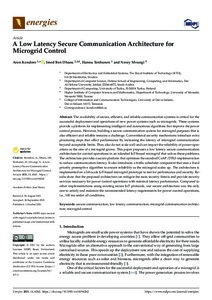A Low Latency Secure Communication Architecture for Microgrid Control
Kondoro Aron; Ben Dhaou Imed; Tenhunen Hannu; Mvungi Nerey
A Low Latency Secure Communication Architecture for Microgrid Control
Kondoro Aron
Ben Dhaou Imed
Tenhunen Hannu
Mvungi Nerey
MDPI
Julkaisun pysyvä osoite on:
https://urn.fi/URN:NBN:fi-fe2021120158447
https://urn.fi/URN:NBN:fi-fe2021120158447
Tiivistelmä
The availability of secure, efficient, and reliable communication systems is critical for the successful deployment and operations of new power systems such as microgrids. These systems provide a platform for implementing intelligent and autonomous algorithms that improve the power control process. However, building a secure communication system for microgrid purposes that is also efficient and reliable remains a challenge. Conventional security mechanisms introduce extra processing steps that affect performance by increasing the latency of microgrid communication beyond acceptable limits. They also do not scale well and can impact the reliability of power operations as the size of a microgrid grows. This paper proposes a low latency secure communication architecture for control operations in an islanded IoT-based microgrid that solves these problems. The architecture provides a secure platform that optimises the standard CoAP/DTLS implementation to reduce communication latency. It also introduces a traffic scheduler component that uses a fixed priority preemptive algorithm to ensure reliability as the microgrid scales up. The architecture is implemented on a lab-scale IoT-based microgrid prototype to test for performance and security. Results show that the proposed architecture can mitigate the main security threats and provide security services necessary for power control operations with minimal latency performance. Compared to other implementations using existing secure IoT protocols, our secure architecture was the only one to satisfy and maintain the recommended latency requirements for power control operations, i.e., 100 ms under all conditions.
Kokoelmat
- Rinnakkaistallenteet [27094]
